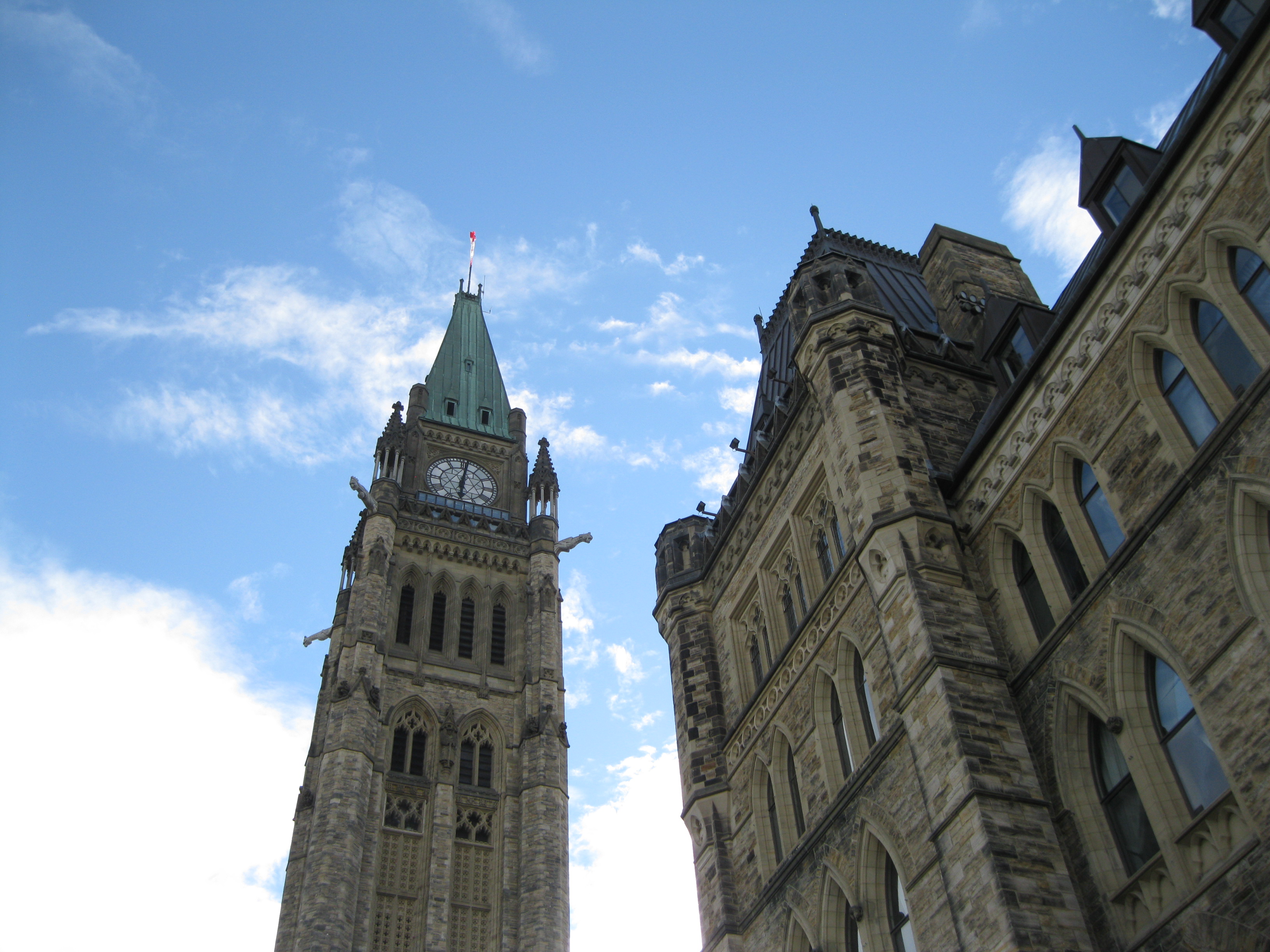Ottawa is the capital of Canada and is located in the province of Ontario. It was founded in 1826, was given the name Bytown and came about due to the construction of the Rideau Canal. It was named after British Lieutenant-Colonel John By, a military engineer who supervised the construction.
John By would divide the town into lots and it later grew mainly due to the Ottawa timber trade. In 1855 it was incorporated as Ottawa and in 1857 it was chosen by Queen Victoria as the capital as it is right on the border to French speaking Quebec. In 1867 this choice was reaffirmed by the Fathers of Confederation who were leading politicians from the British American colonies and the architects of the plan that would result in bringing the colonies together into a Federal Union. This happened on 1 July 1867 with the four present-day provinces of Ontario, Quebec, New Brunswick and Nova Scotia. Even though not all colonies joined they eventually did with Newfoundland being the last to join in 1949. The name Ottawa derives from the name of the First Nations tribe “Odawa”. The Odawa language is a part of the Algonquian language family. First Nations People is the Canadian term for what in the United States would be called American Indian or Native American.
When arriving at Ottawa International Airport going to the city is really easy. If you are in doubt when arriving there a stands with staff from the tourist organisation who are very friendly and can help you out. Taking the bus is the cheapest and also an easy option. Tell the bus driver where you want to get off and he will advise you on where your stop is. This particular stop will be announced when you get there through the speaker system.
Even though English is the official language you will hear both English and French walking around on the street which gives it a pretty cool character.
Doing a walking tour is recommended. It can be done via Ottawa Walking Tours who are really good. They will guide you through the downtown area, point out buildings, monuments and areas with historic significance. Furthermore they will tell you about the political characters, architecture, history of the city and also give you recommendations on restaurants and bars.

Byward Market is a district in the neighbourhood of Lowertown which is really nice is located within walking distances from Parliament Hill. It’s the cultural hub of the revitalised Downtown area with a lot of interesting restaurants, bars, pubs and shops which has breathed new life into the neighbourhood. It has a lot of nice historic architecture and is a really cosy spot with a great vibe in the evening. There are open air farmers’ markets on George, York, Byward and William Streets which is open all year, seven days a week. The food is really good here as there are 1200 farms within city limits which is more than Canada’s other major cities combined. Therefore farm to table is a part of the culture. Local food is huge here and the green symbol of “Savour Ottawa” on the goods ensures that it’s locally grown food. Byward Market has loads of stalls and stores which each has a little something different. Furthermore there are art galleries and entertainment and are a lot of options if you want to find a nice restaurant. Some service organic food and a lot of them get their produce from the Byward Farmers’ Market. Taking a walk through the Sussex Courtyards just behind Sussex Drive is recommended as there are some nice pedestrian areas. Back in the day the canal workers would live in Byward Market where the past times would be drinking, gambling and prostitution which could turn into brawls. It wasn’t until a few decades ago that the area became trendy. Prior to that it was known just as Lowertown.
The Ottawa food scene has changed a lot in recent years. It used to be mainly happening around Byward Market but now pockets are turning up here and there are neighbourhoods and restaurants developing together. Ottawa’s favourite dessert is a pastry called a “beavertail” which was created by the company BeaverTails Canada. They originate from Killaloe, Ontario but opened their first permanent store in Ottawa in 1980. The pastry itself is supposed to resemble the look of a beavertail and you traditionally squeeze fresh lemon on it when you get it served.
Beyond the Pale Brewery is a nano brewery based in Hintonburg which is about 4 km (2.5 miles) from the downtown core. Their ambition is not to dominate the market on a national, regional or city level, but to serve their immediate neighbourhood with most of their beer sold in refillable growlers. Having said that you can get the beer in bars around town and in the city centre. The farmers’ market movement which have become more popular in recent years have sparked the interest for local produce. This has translated into an urge from the people to get local beer as well.
The Rideau Centre is located at 50 Rideau Street in Downtown with both Parliament Hill and Byward Market within walking distance. This is a really nice shopping centre with many interesting shops on three levels and a food court with a great variety of cuisines. Just mind you that the area just outside the centre on Rideau Street is a bit dodgy with a lot of homeless people.
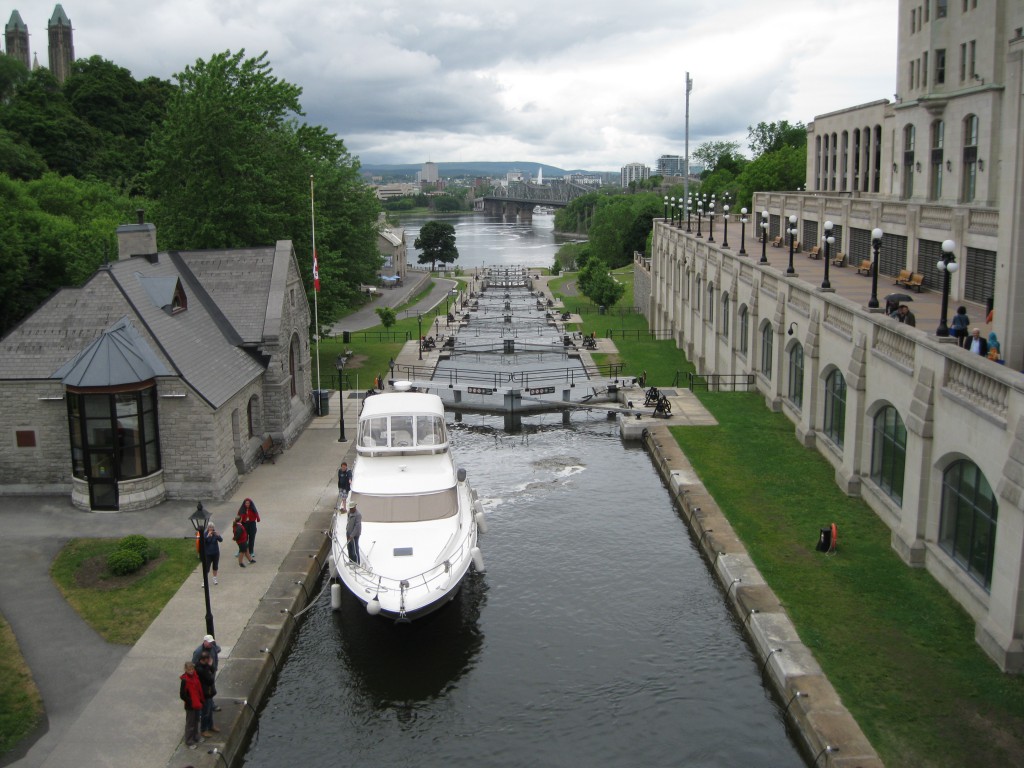
The Rideau Canal was built in 1832 to connect the St. Lawrence River with Lake Ontario to prevent an American invasion. The British brought in thousands of Irish and Scottish workers to complete the 202 km (125.5 miles) long canal which is the oldest continuously functioning canal in North America. It stretches all the way from Ottawa on the Ottawa River to Kingston at Lake Ontario. Today the canal is mainly used for pleasure boating. The locks are in operation from mid-May to mid-October.
During winter when the water has frozen in the Rideau Canal is turning into an ice skating rink and is then referred to as the Rideau Canal Skateway. It is the longest ice skating rink in the world. It is 7.8 km (4.8 miles) long which is the equivalent to over a hundred hockey rinks and handles an average of a million skaters per season. It has been maintained by the National Capital Commission since the winter of 1971. It’s an option if you want to see the sights of Ottawa, get some exercise, but it is also used for commuting to work or school. It can be accessed by 40 stairs along the canal and there are also several service points such as rest areas, heated shelters, change rooms, washrooms, skate rentals, kiosks and picnic tables. Furthermore there are fire pits during Winterlude which is an annual festival celebrating winter. They also have BeaverTails stands on the ice so you can have a break and get a “beavertail”. Furthermore there’s a flag system to signal the conditions of the rink. If the flag is red the canal is closed for skating, if it’s yellow the conditions are fair to good and if it’s greens it’s very good to excellent.
The Ottawa Lockstation is located in small valley between Major’s Hill Park and Chateau Laurier on one side and Parliament Hill on the other. There are 500 metres (1640 ft) from the Plaza Bridge to the Ottawa River and eight locks which are manually operated. Furthermore there’s a pretty neat Lockstation office which is a stone building from 1884.

Chateau Laurier which is located at 1 Rideau Street is one of the most impressive buildings in town. It is a hotel designed in the French Gothic Châteauesque style with limestone masonry and turrets. Construction started in 1909 after being commissioned from the Grand Trunk Railway and opened in 1912. It’s based above the Rideau Canal and Major’s Hill Park. The interior of the hotel is quite impressive. You can walk inside and have a look at the beautiful design.
Major’s Hill Park is nice little breathing space in the city located next to the Chateau Laurier, down to the Ottawa River and between Byward Market and the Rideau Canal. As mentioned earlier Byward Market would be the home of the canal workers but where the park is today is where Lieutenant-Colonel John By, the supervisor on the construction of the canal, had his official residence until he returned to England in 1832. The park is used a lot at different events during the year and is the central for the Canada Day celebrations on 1 July.
Parliament Hill is the location of the Parliament of Canada and is an absolute must to check out. It is situated on what used to be a military base. In 1859 it was decided to construct a governmental residence after Queen Victoria chose Bytown as the capital of the Province of Canada. The complex didn’t get its present day look until 1927 where the Peace Tower in the middle the Centre Block was completed. Prior to that it had undergone a fire in 1916 destroying the Centre Block. Since 2002 extensive renovations have taken place which are not planned to be finished before 2020. The architectural style is Gothic Revival and is really stunning.
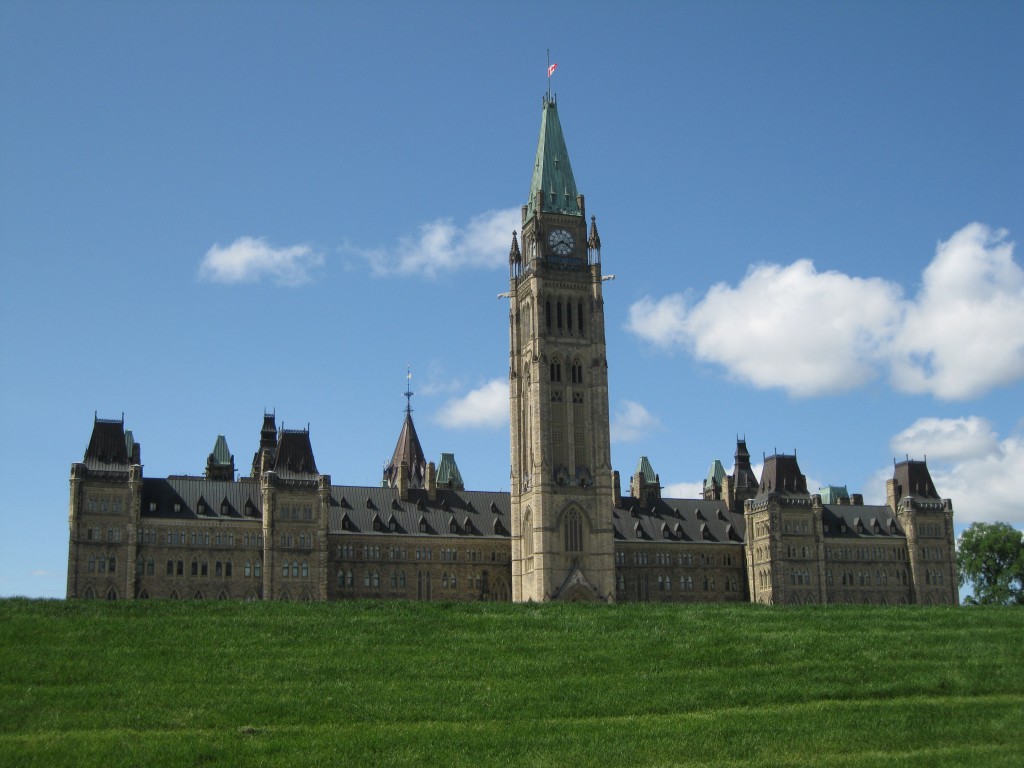
The Centre Block is the main part of the Parliament of Canada. This is where the House of Commons and the Senate are based. After the fire of 1916 all that remains of the original building is the Library of Parliament in the back of the structure which is quite extraordinary as well. Even though construction began right after the fire, sculpting continued until the 1970s.
The House of Commons is a democratically elected body which consists of 338 seats (from October 2015) and is known as the lower house. The members are referred to the Members of Parliament. The Senate, also called the upper house, consists of 105 members who are appointed by the Governor General (the Canadian Monarch representative which the Queen of England as she’s the Head of the Commonwealth) on advice of the Prime Minister. Members are chosen from the four major regions each represented by 24 each. The four regions are Ontario, Quebec, the Maritime provinces (New Brunswick, Nova Scotia and Prince Edward Island) and the Western provinces (Alberta, British Columbia, Manitoba and Saskatchewan). Seats for Newfoundland & Labrador, the Northwest Territories, Nunavut and Yukon are assigned directly from these individual regions. The members chosen for the Senate could be minority groups which are not represented in the House of Common such as First Nations People and besides that it has wide variety of people from all walks of life such as business people, lawyers, teachers, surgeons or journalists. They have a vast range of experience including everything from agriculture, the environment, manufacturing, the police, economics, industries such as oil, gas and fishing and furthermore people with expertise within federal, provincial, territorial and municipal politics.
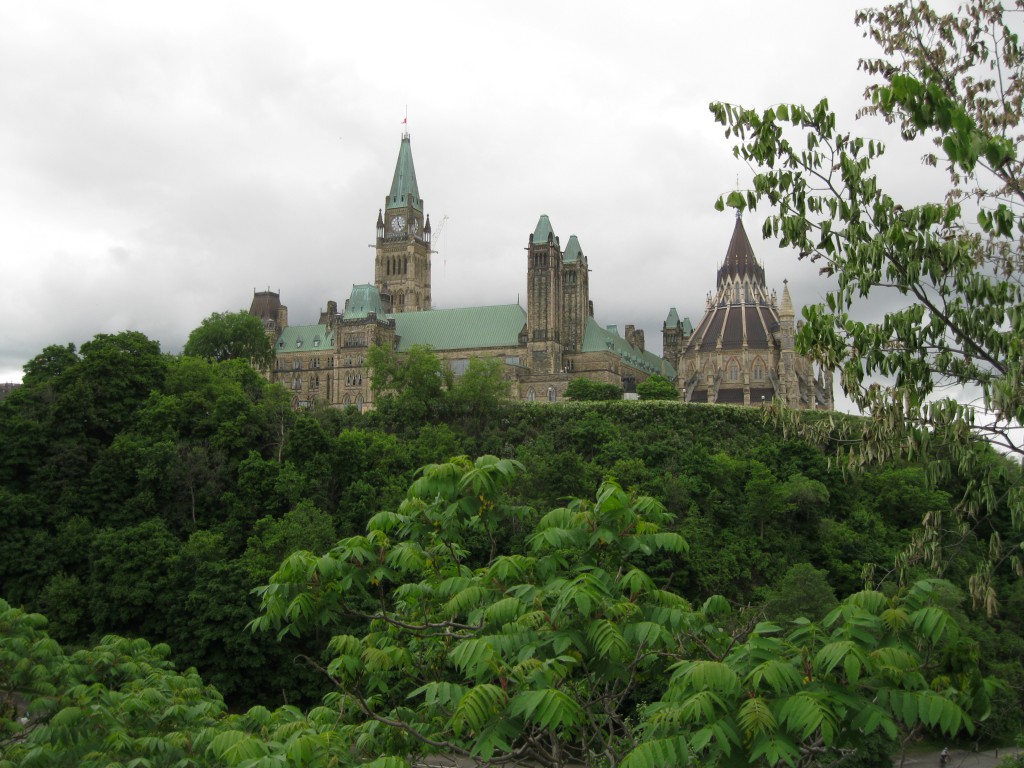
You can join a tour of Centre Block which is for free and is available daily. A ticket has to be reserved and picked up at the Capital Information Kiosk at 90 Wellington Street just on the other side of the road from the Parliament. The tour is very good and educational. You will get to see the beautiful Gothic Revival architecture inside the complex and depending on availability, also the House of Commons and the Senate. The guides are really friendly and eager to answer your questions. The tour also includes a visit inside the library. Furthermore you will also pass the room where delegates of the Provinces of Canada, Nova Scotia and New Brunswick in 1866-1867 framed the Act of the Union where all of British North America except Newfoundland became united under one Government as the Dominion of Canada.
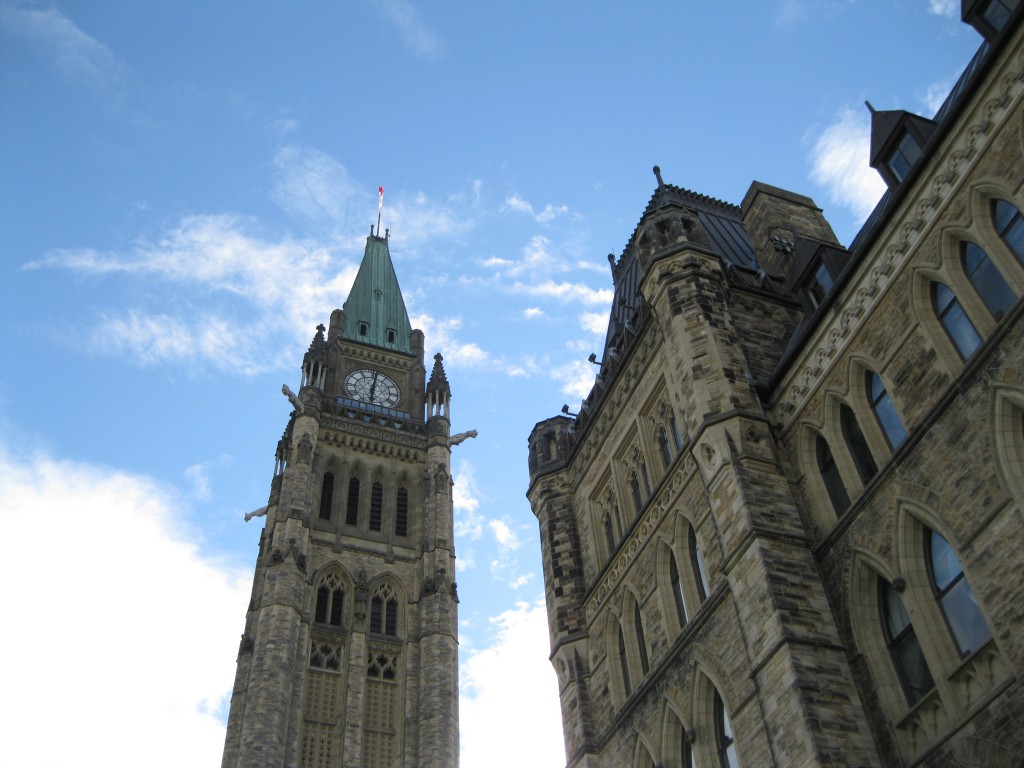
A visit to the observatory at the top of the Peace Tower is highly recommended. Depending on your schedule you could do this after the tour of the Centre Block or you can just do it whenever you feel like it. It’s for free as well and you will get some great views of Ottawa and Gatineau. Just be aware that you will have the obstruction of glass windows when you are taking pictures.
Inside the Centre Block you can also check the Book of Remembrance for Newfoundland’s war dead which ranges from 1867 to 1949.
The West Block of the parliament has been extended twice after its completion in 1865. Even though it is not as famed as the Centre Block it is pictured on the 5-dollar bill. It contains offices for parliamentarians among other things but unlike any of the other structures it is not open for public tours. It’s an asymmetrical structure also in the style of Gothic Revival. Details of the exterior include stone carvings such as gargoyles and friezes keeping it in the same style as the rest of the complex. It has tree towers, the Southwest Tower and two more added after the completion of the building which are the Mackenzie Tower in 1878 and the Laurier Tower in 1906.
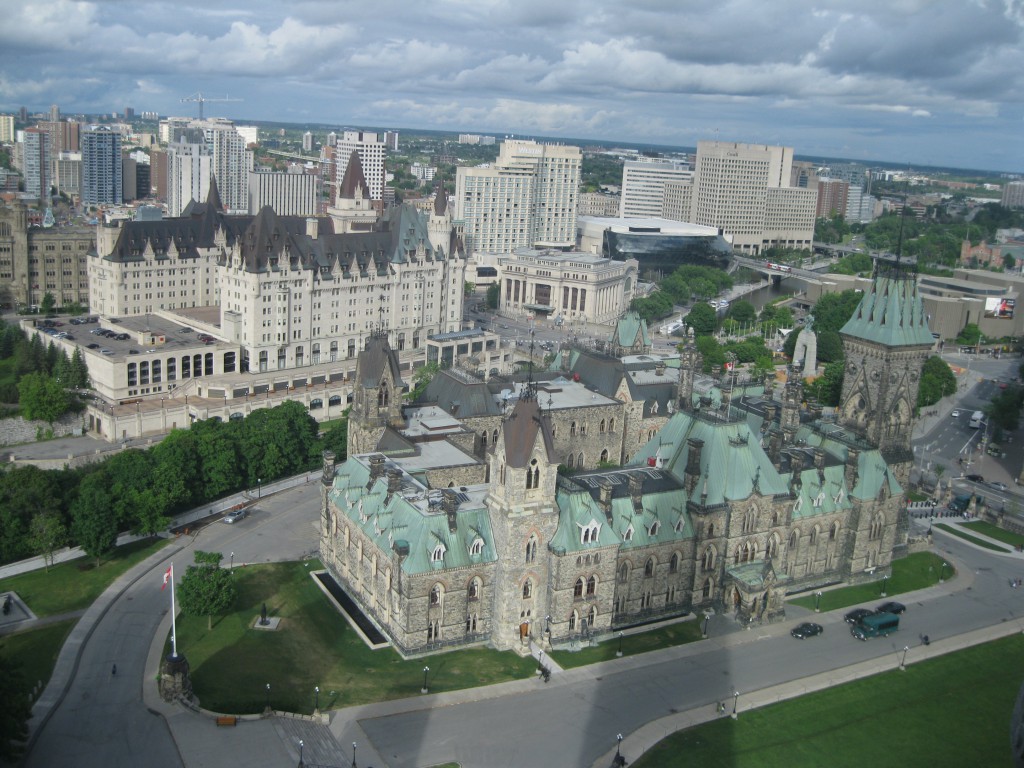
The East Block of the parliament was completed in 1886 and also contains offices for parliamentarians. Along with the Library of the Parliament they are the only two buildings which have stayed in tact since completion. The East Block is also built in the architectural style of Gothic Revival, is asymmetrical with stone carvings of gargoyles and friezes as well. It is open for public tours in July and August.
The Library of Parliament is a yet another stunning structure in the Parliamentary complex which opened in 1876. Keeping in line with the rest of the buildings it is also in the style of Gothic Revival. In contrast to the three blocks it has a really cool circular design with buttresses, pinnacles, decorative windows and ornamental ironwork. If you have a close up look from different angles you will notice how the look changes and the distinctive details.
As mentioned earlier is it located in the rear of the Centre Block and is the only part that survived the fire in 1916. Furthermore it is actually also on pictured on the 10 dollar bill.

Outside on Parliament Hill between the East Block and the Centre Block you will find a statue of the Famous Five which were five women who fought for women to be recognised at persons. In 1927 they filled a petition to the Supreme Court of Canada asking if “persons” according to the “British North America Act, 1867” included female persons so they could be appointed for the Senate. The following year the Supreme Court of Canada unanimous determined that women were not such “persons”. In 1929 this judgment was overturned by the British Judicial Committee of the Privy Council. This case was a big influence on the fight for women’s rights.
You can easily spend an hour or so just walking around the buildings of the parliament, checking out the architectural details and take photos. The location is also amazing on the hill at the Ottawa River. On the backside of the Centre Block you will have a perfect view of the river and Hull.
The Langevin Block is located at 80 Wellington Street opposite the Parliament complex. Among other things it is the headquarters of the executive branch of the Canadian government and the office of the Prime Minister. Construction of the building started in 1884 and was completed in 1889. It is a beautiful four storey structure and a fine example of Second Empire architecture of sandstone with arched windows, decorative features and a copper mansard roof. The term “Langevin Block” has become a figure of speech for the Prime Minister’s office. The building is named after one of the Father of Confederation and cabinet minister Hector Langevin. As opposed to its neighbour the United States, the Canadians are more modest when it comes to monuments, the residence and offices of their leaders but also the orchestration of major events. For instance when the Canadian Prime Minister presents an official guest such as a head of state of a foreign country for the press it is simply done on the steps at 80 Wellington Street of the Langevin Block. The only head of state who you will not see here, is the United States President as the Secret Service of the US have determined that that location is not safe enough.

The Canadian War Museum located at 1 Vimy Place about 2 km (1.2 miles) from Parliament Hill and is really amazing. The museum was opened on 8 May 2005 on the 60th anniversary of the end of World War II in Europe. The exterior is quite impressive as it emerges from the ground just west of Booth Street and rises progressively higher at the eastern end. The concrete façade is similar to the look of a bunker while the partially grass-covered roof fits in with the museum’s theme of regeneration. The building rises to the east with a large fin cover in copper. The small windows on the fin spell out “Lest We Forget” in Morse code and “N’oublions jamais” which is the French equivalent. These are the two official languages of Canada. The copper used on the interior was originally from the Library of the Parliament which was removed after the refurbishment of the roof in 2004.
The museum’s galleries and public programmes have been designed to emphasise the human impact of war, and how Canadians have effected and been effected by the world around them through war, conflict and peace support operations.
The museum is one of the highlights of Ottawa and a visit here is highly recommended if you are in to Canadian history, war history or history in general. You can easily spend about five hours here. There are four galleries which will take you all the way through Canadian war history chronologically from the very beginning to present day. A lot of interesting historical facts are on display along with photos, artefacts and models which highlight defining moments in Canada’s military history and how they have shaped the nation.
The museum is split into four galleries which are: “Gallery 1: Battleground” which covers the earliest times to 1885, “Gallery 2: For Crown and Country” on the South African and First World Wars from 1885 to 1931, “Gallery 2: Forged in Fire” on World War II from 1931 to 1945 and “Gallery 4: A Violent Peace” on the Cold War, Peacekeeping and recent conflicts from 1945 to the present.
It is not certain when war began in Canada but archaeological evidence shows that violence between humans dates back 5,000 years. Shallow graves have been found at Namu, British Columbia containing victims of club blows which fractured skulls and facial bones. The Vikings visited from Greenland around year 1000 at an established outpost at L’Anse-aux-Meadows in present day Newfoundland. Sometimes they would trade or they would just strike without warning. But they were not able to defeat the First Peoples.
The French settled in Quebec which was founded by Samuel de Champlain in 1608 to trade with the First Peoples. He organised the construction of fortifications for defence against European rivals. Quebec occupied a strategic important site where the St. Lawrence River narrowed and built a fort to control the traffic on the River. This would become an important port where France would collected Canadian products and unload cargos for the interior of Canada. In 1640 the French would be based at Quebec City, Trois-Rivières and Montreal.
The American Revolution created two countries which were the United States and Canada. In 1775 the Rebels from the United States would invade Canada to secure the northern frontier. The British colonies that joined the rebellion would become the United States and those who defeated the American invaders and local rebels would later join forces and form Canada. The United States declared war on Britain in 1812 in response to British interference with American ships and contact with First Peoples who were resisting American expansion. Canada was attacked in hope of capturing new land but from 1812-1814 the British army, First Peoples and Canadian militia would fight against American invasion and saved Canada from annexation.
The emergence of Canada as a self-governing country was partially due to several of 19th century wars. In 1870 the First Peoples controlled the Prairies and used for hunting but by 1880 it was taken over by settlers who converted the land into farms, towns and cities linked by railway and telegraph lines. Many First Peoples disliked the settlers but ended up converting their economies from hunting to farming. They relied on Ottawa resolving their differences by negotiations. The Prairie warfare took place from 1853 to 1885.
The exhibition on the First World War is quite impressive as well. On display is a German 77 millimetre gun which the Canadian infantry captured during the attack on Vimy Ridge. Its muzzle was destroyed but it is unclear how this happened. Many aspects of Canadian life today are legacies of the First World War. The right for women to vote was an important early step for equal rights for women in Canada. The government proposed daylight saving to allow more time for war work and increase productivity. The people of the cities liked the idea in general but it was more unpopular in rural areas where farmer were opposed to the change. Saskatchewan never adopted the pratice. Most parts of Canada introduced daylight savings. The federal government issued bonds to get funds for the enormous costs of the war which were easily sold to the public. Furthermore they introduced a “temporary” income tax which never went away. Sounds like something we have heard of before in history.
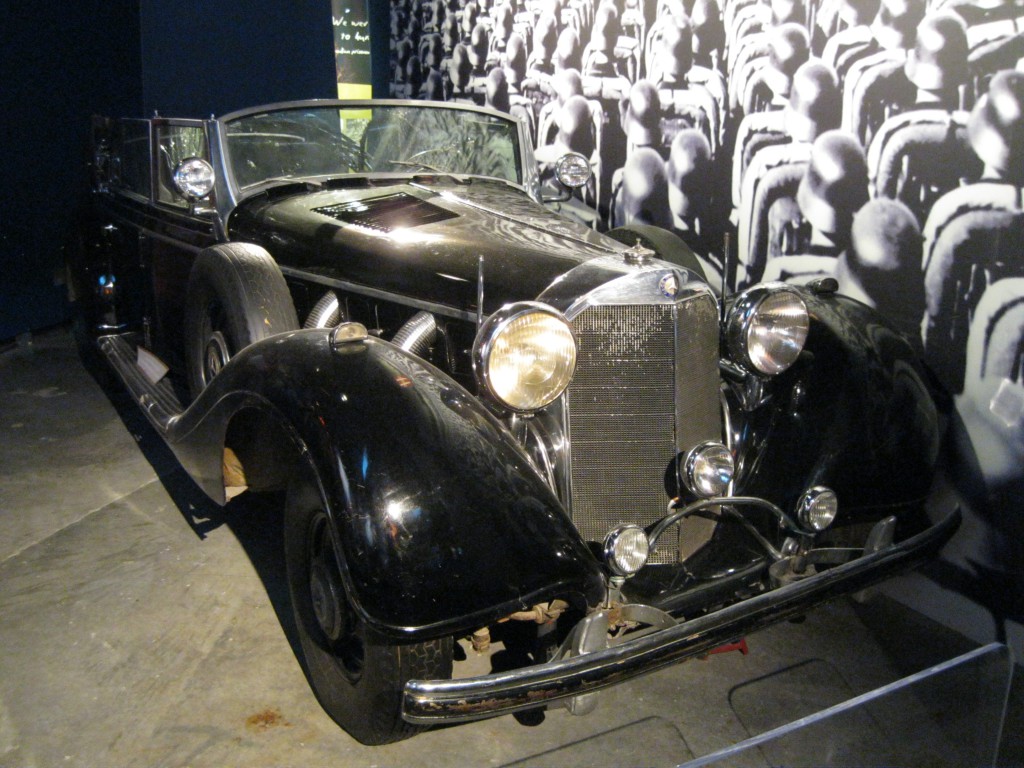
On display is Hitler’s Car which was used as a parade car. It was captured by American troops in 1945 and brought to Canada a few years later. Furthermore a German torpedo from World War II is on show which was a dreaded weapon in the Battle of the Atlantic. An artefact showing show the Japanese balloon bombs work is quite interesting. In 1944 Japan launched more than 9,000 of the bombs which look a bit like a hot air balloon. It was hopped that they would spread panic and fires in North America, but only 300 were known to reach the continent and 80 in Canada. One reached all the way to Manitoba. Six people were killed and all in the United States. On D-Day (6 June 1944) the allied naval forces included 110 Canadian warships and 10,000 sailors in support of the Normandy landings. They helped protect the invasion fleet, cleared German minefields, bombarded German coastal positions and transported Allied troops across Channel. Some 14,000 Canadians were among the almost 150,000 Allied troops who were landed or parachuted at the area of invasion. In the exhibit there is a landing craft simulator where you can get kind of a taste of the experience. There were more than 200,000 Allied casualties of which 18,500 were Canadian and 5,000 of them died. Also on display is a Sherman tank called Forceful III which survived fighting in France, Belgium, the Netherlands and Germany.
There is information about Canada’s important part in the negotiations for the NATO treaty and their involvement in the Korean War, the Cold war and the Canadian view on the Cuban Missile Crisis of 1962. Canadian Prime Minister John Diefenbaker did not get along with US President John F. Kennedy at all. Canadian officials were divided on how to respond. Defence Minister Douglas Harkness quietly moved Canadian forces into a higher alert status. Minister of External Affairs Howard Green and Prime Minister Diefenbaker remained undecided. The cabinet debated for two days and then decided to officially authorise the alert.
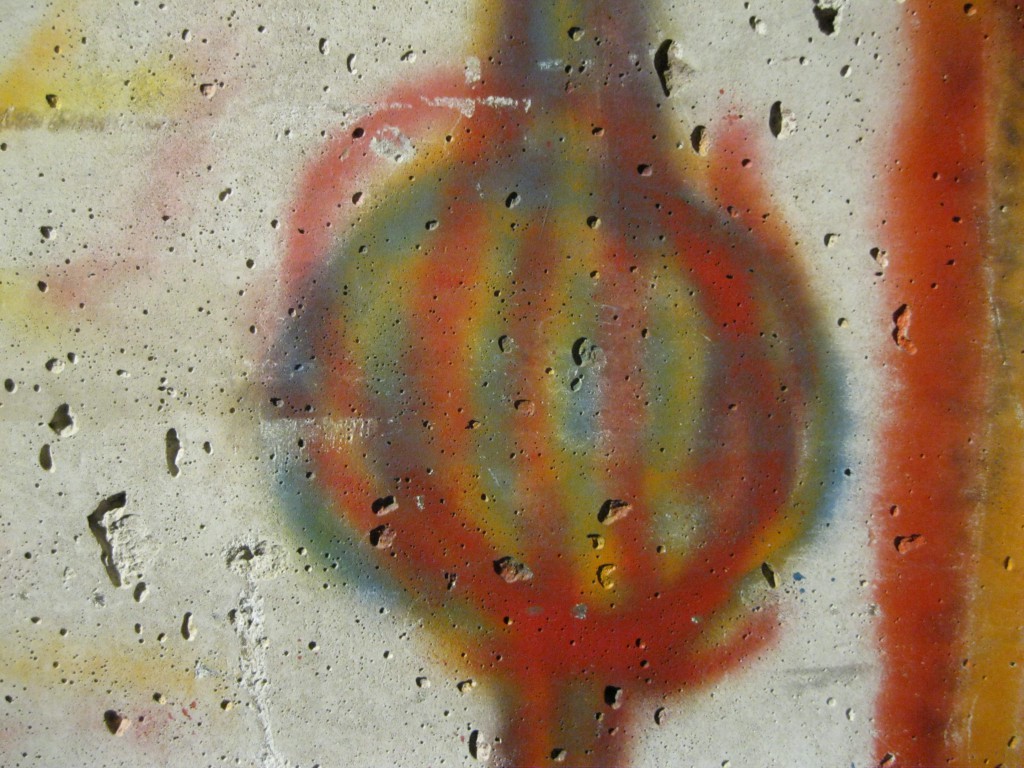
In 1991 the German government presented a section of the Berlin Wall to Canada. It is on display and is really cool. A year earlier foreign ministers of West Germany, the United States, the Soviet Union, the United Kingdom and France had conferred in Ottawa on how to make a peaceful reunion of Germany. The graffiti on this section of the wall portrays the Alexanderplatz television tower in East Berlin, the Brandenburg Gate, a crossing between East and West and the Berlin radio tower in West Berlin. There is no graffiti on the reverse side of the wall as that is from the East German side where guards would have arrested or shot anyone attempting to reach the wall. Looking at the wall from the side and you will see how thick it was.
Memorial Hall is designed for rest and reflection. It contains one artefact which is the headstone of the unknown soldier from the First World War. At 11:00 each Remembrance Day on 11 November the sun will shine through the only window on the wall to exactly frame the headstone. Also notice the offset grooves between the concrete rectangles on the walls. These symbolise the rows of the white grave markers in Allied war cemeteries. Remembrance Day is a memorial day in the Commonwealth of Nations since the end of the First World War and is a statutory holiday in all three territories and the provinces with the exception of Nova Scotia, Manitoba, Ontario and Quebec. It’s a day of national commemoration for the more than 100,000 Canadian who have died in military service.
Canadian singer, songwriter and musician Bryan Adams co-wrote a song called “Remembrance Day” with Jim Vallance in January-February 1986 for the album “Into The Fire” released in 1987. Bryan Adams is a native of Kingston, Ontario based at the bottom of the Ottawa River which was connected with the St. Lawrence River due to the construction of the Rideau Canal. The city of Kingston is also mentioned in the song. The inspiration for the song “Remembrance Day” was Jim Vallance’s great uncle who had fought at the end of the First World War. His name was Jim Young and he ran a grocery store in Vancouver in the early 1900’s. As the store was a big responsibility Young didn’t not enlist himself when the war broke out in 1914. As the war dragged on and many allied soldiers died there arose an urgent need for replacements at the front. In 1917 the Canadian government passed the Conscription Act which allowed an endless amount of soldiers for the front or to be blunt “cannon fodder”. Young was drafted in January 1918 and his younger sister Ethel, Jim Vallance’s grandmother, would take over the store. In June 1918 he joined the British Expeditionary Force in France and was killed by a shrapnel on 27 September 1918 after crossing the Canal du Nord just a few weeks before the end of the war. He was buried in a small British war cemetery close to the village of Sains-les-Marquion in France. This is just one out of many stories of Canadian soldiers during the First World War and this particular story was the inspiration for the poetry and music for two of the best songwriters of Canada being Bryan Adams & Jim Vallance.
In 1988 Adams and Vallance were approached by the Canadian Ministry of National Defence requesting that the song could be used in a video production to be played in schools across Canada on every 11 November. They permitted the use of the song and were later thanked in letter by the Minster of National Defence Perrin Beatty personally on 2 September 1988.
Canada’s involvement in the First World War was big. At that time in 1914, when Britain was at war so was Canada, but the Canadians would determine their own commitment. Canada was a self-governing dominion of the British Empire but was not in control of its foreign affairs. Most of the people of the country, but definitely not all, would agree with the Prime Minister Sir Wilfred Laurier that “When Britain is at war, Canada is at war. There is no distinction”. There was a big debate in the country on size and nature of the war effort and also increasingly the relationship with Britain. By the end of the war 619,000 of the people would have been enrolled in the war overseas out of less than 8 million which is more than 7% of the population. More than 61,000 died and more than 154,000 were wounded.
The Royal Canadian Legion Hall of Honour documents important and historical events of Canada. It includes military honours, certificates of service, Remembrance Day poppies, war art and other material to commemorate the military.
The Panoramic LeBreton Gallery contains a voodoo jet, 19th century artillery pieces, tanks and vehicles. In the regeneration hall you will find the original sculptures of the statues found at the Vimy Ridge Memorial in France. There are many interesting vehicles on display such as the Goliath Demolition Vehicle which was remote controlled to destroy fortifications and clear minefields during World War II. Germany built more than 7,500 Goliath during the war. Furthermore the Great Eastern Ramp which was a specialised engineering tank also developed during World War II to help vehicles drive over obstacles such as walls. The one on display is one of ten Churchill tanks which were converted. Besides that there are several tanks and other vehicles.
The museum also has a souvenir shop with accessories and military literature.
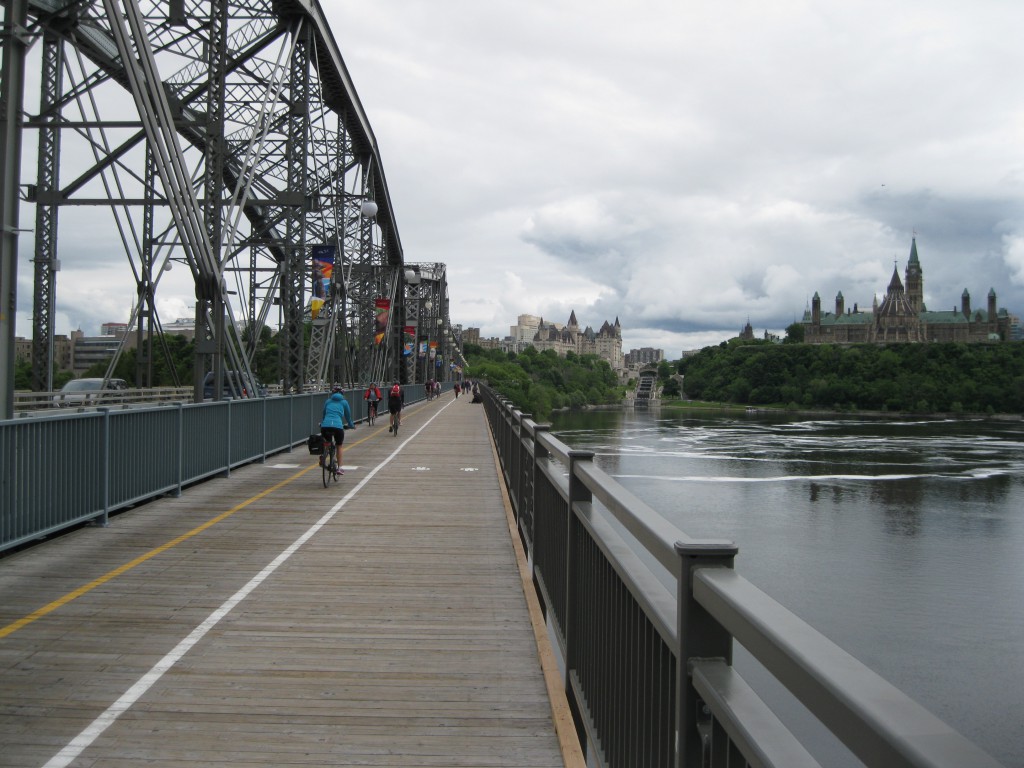
Ottawa is right on the border to Hull which is the oldest part of the city of Gatineau in Quebec. Therefore it is a great option to walk across the Alexandra Bridge from Ottawa in Ontario to Hull in Quebec which will take you less than 5 minutes. On the bridge you will have plenty of opportunities to take photos of Parliament Hill and Hull. You can cross the bridge after you have visited Parliament Hill. As mentioned earlier, English is the official language in Ottawa and you mostly hear this language on the streets of town, but both English and French is widely spoken. The fascinating thing after you have crossed the bridge to Hull all you hear is French and it’s just on the other side of the river in the same country.
In Hull there are several of interesting things to check out. The Canadian Museum of History (formerly the Canadian Museum of Civilization) located at 100 Rue Laurier (Laurier Street) which was established in 1856 is an interesting museum about human and cultural history. It is the biggest museum in Canada and has more than 1.2 million visitors a year and is home to more than 3 million artefacts.
It was moved to the current location in 1989. The exterior of museum building is pretty neat too, the architectural style is postmodernism and was designed by Douglas Cardinal. The unique feature of the building is the curvilinear style and you won’t find any straight lines in its design. The entrance to the Public Wing at Laurier Street is reminiscent of a turtle head which is a native symbol of Mother Earth. The glazing of the Public Wing is intended to be symbolic of a melting glacier. The cantilevered levels of the Curatorial Wing represent the visible exposure of bedrock at the Canadian Shield. The Grand Staircase between the two wings is really nice with a plaza at the foot of the stairs leading to a park at the Ottawa River. Here you will have a stunning view of Ottawa and Parliament Hill. A perfect photo opportunity.
The museum has three permanent exhibitions which are the Grand Hall, the First Peoples Hall and the Canada Hall. The Grand Hall is the home to the largest indoor collection of totem poles in world. Furthermore there are recreations of six Pacific Coast Aboriginal houses which are connected by a boardwalk. From the Grand Hall you will also have a great view of the Ottawa River and Parliament Hill through the large windows. The First Peoples Hall is an exhibit on the First Nations of Canada, their culture, traditions and accomplishments through 20,000 years of history.
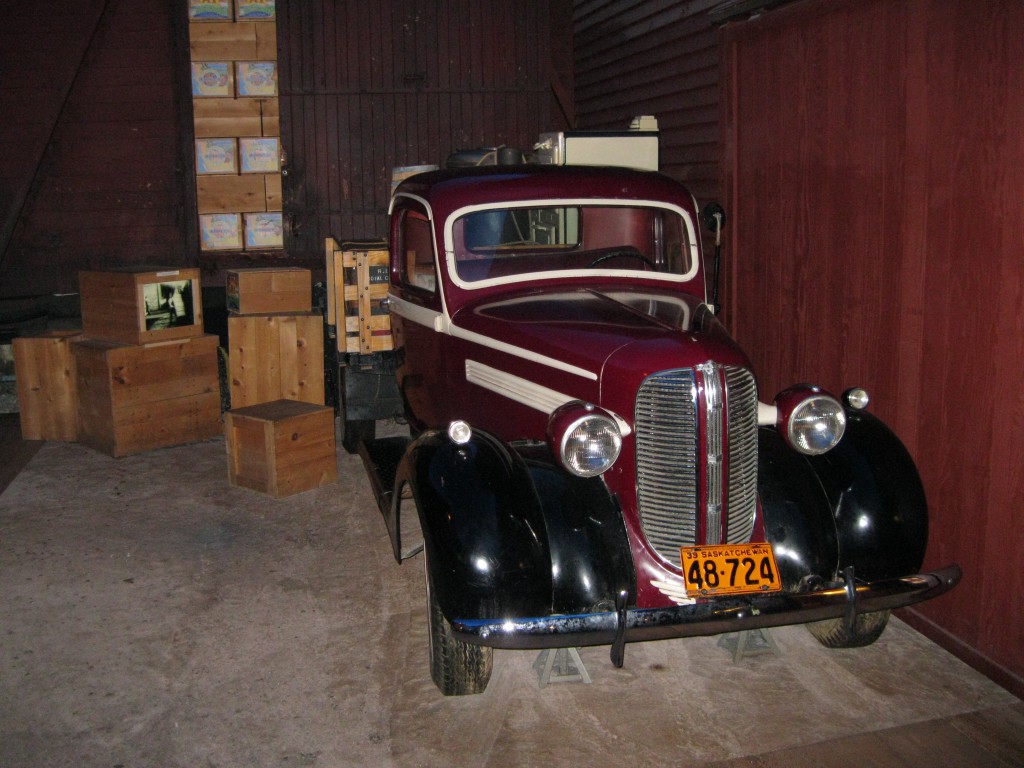
The Canada Hall is the highlight of museum which takes you through one thousand years of Canadian history through life size environments such as reconstructed streets and houses of different periods with all sorts of artefacts such as cars, furniture, decorations etc. Really impressively made. It starts with the Vikings being the first known non-Aboriginal people to set foot on present day Canadian land, so the journey starts on the East Coast moving westward through time following the Canadian development from coast to coast. Along the way you will learn about the history of the immigrants coming to Canada, their challenges and contributions to the nation. There are several impressive recreations such as New France farmhouse and a part of a main street which would be typical of an early Ontario town.
Furthermore there is the Children’s museum is also quite interesting. Also the Canadian Stamp Collection with a collection of more than 3,000 stamps which are all the stamps Canada has ever issued. Discover the history behind the creation and the printer’s proof of several of well-known Canadian stamps.
Afterward you could have walk around the neighbouring streets in Hull where you will find some nice historic residential buildings.
